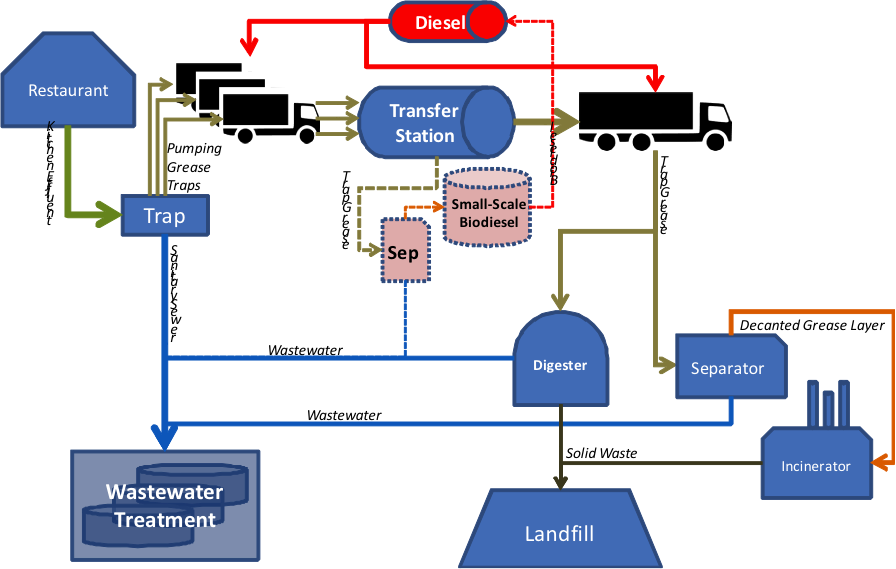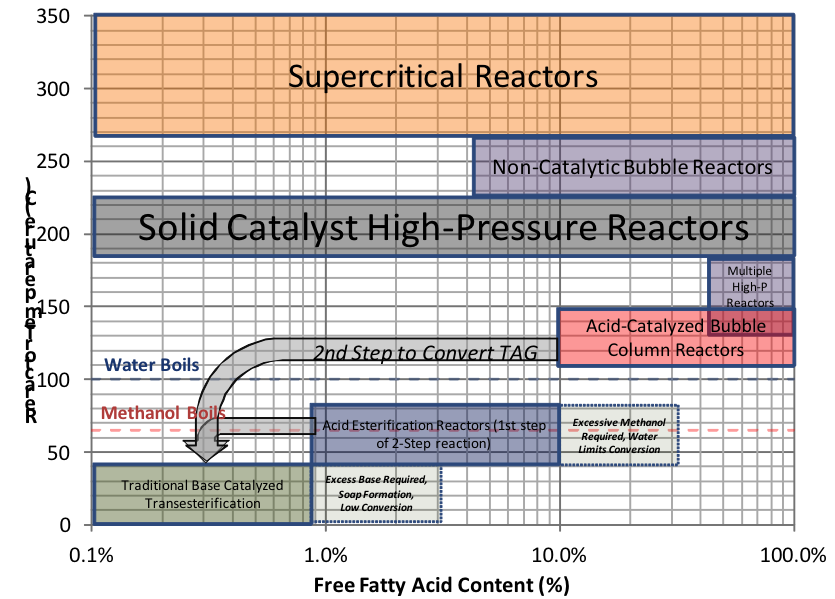I. TECHNOLOGY DESCRIPTION:
The focus of this project is a bubble column reactor (BCR) that is robust for production of biodiesel from impure and degraded fats, oils and greases (FOG). The waste stream that is the focus of this project is trap grease, which is a significant burden on the solid and wastewater management systems. Our initial research was funded by the EPA P3 (People, Prosperity, and the Planet) program and demonstrated that the lipids from trap grease can be effectively and economically converted to biodiesel in the BCR. The bubble column reactor is critical part of a system that separates lipids from trap grease, reacts lipids with methanol to make crude biodiesel, purifies the biodiesel, and recovers and recycles unreacted methanol (see Figure 1).
Currently the standard methods for disposal of trap grease within the solid waste management system are incineration and anaerobic digestion (see Figure 2). Food service companies typically pay about $0.20 per gallon to "grease haulers" (companies that collect grease from distributed sources and deliver grease to waste water treatment plants), the grease haulers accumulate trap grease at a transfer station, and the grease haulers pay about $0.10 per gallon tipping fee to dispose of the trap grease. In the USA, the quantity of trap grease is enough to produce more than a billion gallons of biodiesel per year. Trap grease is a dirty, highly-variable, and inhomogeneous mixture of FOG, water, sediments, food particles, hair, etc.; however, after settling at moderate temperature (60°C or 140°F) a coffee-colored layer of lipids floats to the top (See Figure 1) that comprises 10-40% of the volume and has high acid number (a rating of the amount of degradation of the FOG). The BCR is especially suited for the high acidity of trap grease lipids. There are other high acid number waste lipid feedstocks, such as inedible tallow and greases that are produced on a similar scale to trap grease and may be an additional market for the proposed process.
We have demonstrated that the high acid number lipids from trap grease can be converted to biodiesel in the BCR. We have demonstrated robustness of BCR performance for varying operating conditions, alcohol flowrate, water content in the alcohol, and acid number of the lipid. In particular the methanol vapor bubbles rising through the BCR strip water (a by-product of the reaction) and circumvent reverse reactions that limit conversion. Other biodiesel reactors are much more sensitive to water with reports of less than 1% water leading to more than 50% reduction in conversion.
The laboratory-scale BCRs at Drexel have effectively produced ASTM-quality biodiesel from oleic acid, which is a model of trap grease lipids. Also, lipids, separated from trap grease by heating and decanting, have been reacted to biodiesel (Figure 2); although additional purification by distillation is necessary to meet ASTM specifications. The BCR has been tested with real trap grease lipids but the pretreatment and purification techniques need to be implemented in an operational environment. The proposed project will demonstrate the performance of a trap grease to biodiesel process in an operational environment. We plan to construct a demonstration-scale prototype at a transfer station that will produce approximately 50 gallons of biodiesel per batch from 150-500 gallons of trap grease. Regular processing over several months will enable developing statistics of the feedstock variability and performance robustness of the process. After confirming biodiesel quality against ASTM specifications, the trap grease biodiesel produced in this process will be blended with petroleum diesel and used in selected trucks to document reliability.

Figure 1: Several stages of experiments converting trap grease to biodiesel. From left to right: raw trap grease, trap grease after heating and separating into layers, decanted and filtered lipids from trap grease at room temperature in a solid state, and crude biodiesel produced from trap grease.
DEFINING THE INDUSTRY
Biodiesel is a drop-in fuel and is environmentally friendly with significantly lower greenhouse gas emissions than petroleum diesel. The soybean-based biodiesel industry in USA is struggling and requires government subsidies because the cost of soybean oil ($3.50/gal) is similar to the selling price of biodiesel ($3.90/gal). Waste FOG to biodiesel is currently practiced mostly by small-scale homebrewers and companies using yellow grease or waste fryer oil (a much cleaner feedstock than trap grease selling at ~$3/gal). Several companies promote black grease or trap grease to biodiesel processes (including Black Gold Biodiesel, Viridia, and Biobox fuel) but none of these companies appear to have been able to expand their operations beyond demonstration scale.
The alternative reaction technologies for producing biodiesel from high acid number lipids (See Figure 3) all have limitations: (1) high temperature, pressurized reactors with water removal between each reactor, (2) Supercritical reactors at very high temperature and pressure, and (3) Solid catalysts. The trap grease to biodiesel companies do not advertise the details of their technologies nor the challenges that are limiting their ability to have high market penetration, but it appears that handling the diverse and dirty feedstock is a challenge. The BCR process is more robust for impurities such as water that limit conversion in current technologies. Feasibility studies at Drexel predict lower capital and operating costs with BCR and better environmental impact.

Figure 2: Schematic of current waste management system for trap grease and the proposed transfer station scale biodiesel process. Proposed process is indicated by dashed lines.
CREATING A VIABLE BUSINESS
In this project, a demonstration-scale BCR process will be implemented on-site at a transfer station with a solid waste management partner. Data gathered will be used to prove the technology, guide process scale-up in an operational environment, and refine the economic model. An outcome of this project will be a company that designs and constructs BCR processes, installs them on-site at transfer stations, trains operators to run the BCR process, and is available for on-going support of operation. Experience of running the demonstration-scale BCR process will be critical for establishing appropriate maintenance protocols. Several technical risks will be addressed during this project: effective lipid separation from trap grease, variability in feedstock composition, purification of crude biodiesel by distillation, scalability of the process to the scale of a transfer station (200-4000 gallons of biodiesel per day) or a regional wastewater treatment facility (>10,000 gallons of biodiesel per day) and changing economics for waste handling.

Figure 3: Comparison of reactor technologies for converting oils and greases to biodiesel based on the published ranges of temperature and free fatty acid contents that produce high conversion.
Novel Reactor Design for the Production of Biodiesel from Free Fatty Acids





